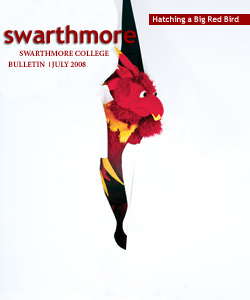Swarthmore Shouldn’t Stand Apart on Environment
As a recent graduate of Swarthmore, I was deeply concerned by the attitude displayed in the April 2008 Bulletin article “Our Own Shade of Green.” The article begins by introducing three indicators used by major national organizations to measure commitment to environmental stewardship in American universities. It notes for each of these indicators that Swarthmore either fails to measure up to its standards or receives only a satisfactory grade.
Surprisingly, the article uncritically endorses Swarthmore’s lone-wolf approach to environmental action at a time when global climate change—among many other far-reaching contemporary ecological issues—desperately calls for cooperative action from the interpersonal to the international level. The article states that the path Swarthmore has taken to date in this arena reflects the institution’s traditional manner of making decisions—what it calls “thoughtfully, analytically, collectively, and, carefully.” Yet we must take care not to use these words as a cover for indecision, inaction, and ultimately, narrow-minded concern for our own short-term interests and image pursued without attention to the real and pressing needs of the global community.
With its elite standing among academic circles and its brilliantly talented students, faculty, and administrators, Swarthmore has the power to critically engage with both the positive and the negative aspects of environmental initiatives created by the thoughtful, analytical, and passionate consideration of countless individuals working together. Swarthmore can play a role in pushing these initiatives to their full transformative potential not by simply dismissing those initiatives in which the College does not wish to participate or disdainfully shying away from involvement when it receives an “unsatisfactory” grade. Rather, we must work collaboratively, rigorously, and respectfully with others who hold in their heart the same humanitarian values as we do while at the same time acknowledging and honoring our differences.
Many of the initiatives with which Swarthmore eschews involvement, in fact, have been explicitly designed with a built-in flexibility that accounts for the unique characteristics and needs of different institutions. Swarthmore does not stand alone, therefore, in finding its “own shade of green.” It does stand apart from many of its peers in espousing the view that carving out its own way means rejecting ties to collective efforts that may challenge the College to stretch beyond its comfort zone. I believe that when we, as an institution, can work with and for others—not just above and in contrast to others—we can honestly call ourselves role models in creating the society we envision.
Ashley Werner ’08
Mill Valley, Calif.
 Email This Page
Email This Page